8 Mistakes That Kill Your Texts Conversion in 2017
Be honest:
Why do you need texts in 2017, the era of visuals, videos, and snap chats?
It stands to reason:
When you write blog posts, they build trust, ensure engagement and nurturing, increase traffic, and craft you an image of an influencer. When you write sales copies, they introduce a product/service to consumers, reveal its USP, build trust to your brand as well as give a clear call to action. In other words, such texts convert.
Isn’t it the best and most evident answer to the aforementioned question?
And here comes the problem:
Despite the evergreen “content is king” mantra and hundreds of articles/guides/e-books/workshops/seminars on the topic, most marketers – yes, even those savvy –continue hitting a plateau when it comes to texts conversion. In 2017, lousy sales copies happen to be so far, and the reason for that is simple:
We focus on a plethora of writing techniques to create one-of-a-kind texts but don’t mention those teeny-tiny details influencing a conversion rate. They sound obvious, so we see no rationale for concentrating on them.
What a shame!
Take a look at the most common mistakes marketers make when writing, checking for plagiarism, and distributing texts. Often invisible, they can kill conversion while their avoidance moves the needle and brings more leads.
#1. Generic headlines
Avoid “neither here nor there” headlines, especially when crafting a sales copy. They frustrate people, don’t bring any information, and make you look like an imposter in the eyes of readers.
Also, such headlines don’t answer “What’s in there for me?” question: visitors don’t understand what makes this text different and why they should keep on reading it.
Examples of generic headlines:
- How to Lose Weight
- About Us: Pizza in Chicago
- Toys Are a Symbol of Childhood
And here goes a captivating title from WordStream:

To create stellar headlines for your texts, try to walk in a reader’s shoes and answer the question “So what?” Also, you might want to analyze headlines with tools like Buzzsumo or CoSchedule, consider power words to include there and use A/B testing of blog titles for neat conversion.
#2. Wordiness
Forget about generic introductions with no hooks, no APP method, and no reference to your target audience. They are balderdash, and they do nothing but bring to naught the desire to read your text and examine what you want to tell.
Example:

Do you know that 55% of visitors read your articles for 15 seconds or less? So wordiness is not your best weapon here: no reference to particular problems and no explanations or previews of how you are going to solve them bring disappointment rather than conversion.
And here goes the example of an insightful introduction:
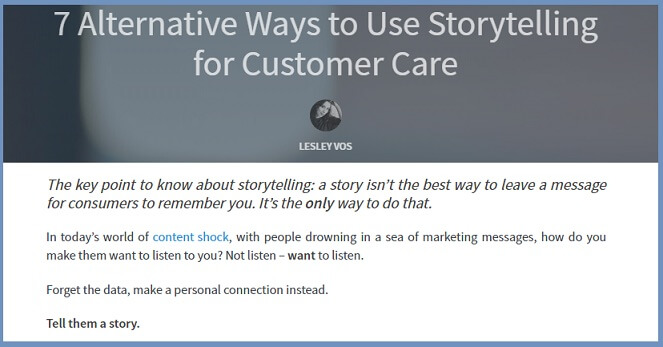
#3. Information lack
Don’t hesitate to share the information about your brand, product/services, team, USP, and contacts with your readers. Sounds obvious, but today in 2017 we still meet this kind of pages online:
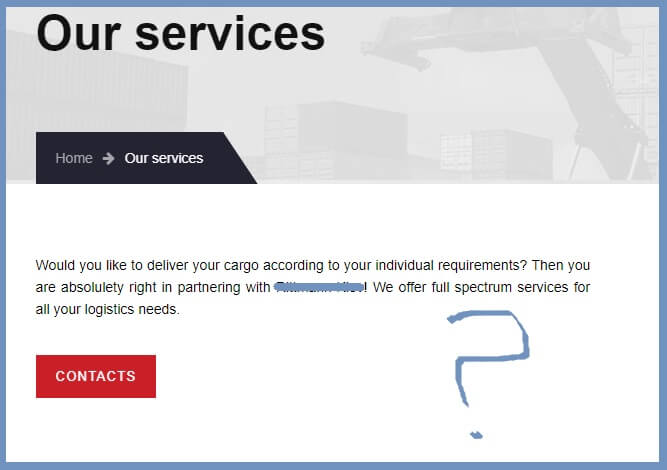
How do you like it, huh?
Does anyone hope such texts convert?
Describe profits a visitor will get if order from you. Mention details that might be of your target audience interest. And remember the core rules of copywriting: write about people, not brands; and tell rather than advertise.
#4. No blog updates
Blogging is the new black. Yes, again.
In her article for HubSpot, Corey Wainwright reveals all benefits of blogging for business and marketing: it drives traffic, establishes authority, and brings long-term results. To enhance those results, you might want to create a news page alongside your business blog to build trust and awareness.
That’s well and fine, but:
Make sure you update the blog and news page regularly; otherwise, it will give the impression of your business stagnation.
To tell firsthand:
As a passionate guest author, I wanted to contribute my latest article to one brand. But after visiting their business blog, I saw this:
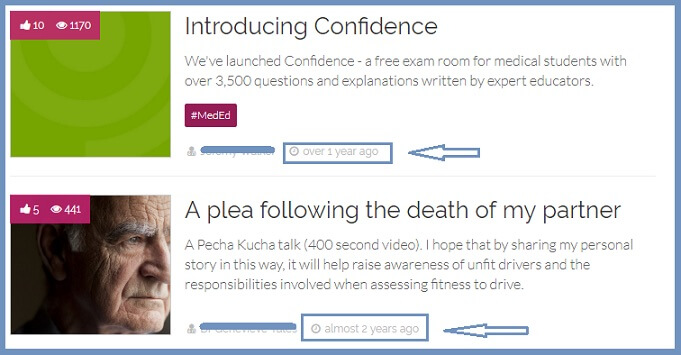
Guess what?
I’ve given up the idea of contribution. The blog seems dead, and so does the website. If you have information on their sky-high text conversion – let me know.
#5. Gobbledygook
Avoid marketing fuzz words and copywriting cliches in your texts. People don’t like them. Period.
When crafting sales copies, forget these words:
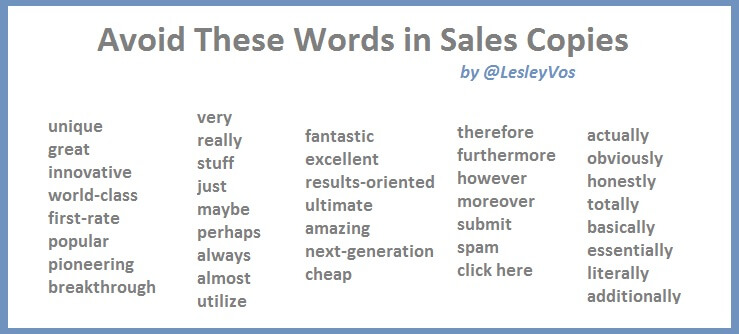
Also, don’t make your texts sound pompous. Consider the language your target audience speaks: be clear, use short words and sentences, write the way you talk, and develop your brand voice and tone.
After spending ten years for doing PR for Apple, Cameron Craig recommends keeping texts simple and easy for an 11-year-old child to understand. For that, you might want to consider services like Readability Score and Word Count Tools.
#6. Generalization
What is the generalization in writing?
It’s a statement or idea applying to a group of people or issues. As a rule, it can’t be an ultimate truth because examples of situations or individuals exist which don’t apply to that generalization.
Thus, poor copywriters love starting texts like this:
- Every girl dreams of getting married one day.
- College is the only way a person can become intelligent.
- Everybody loves a trip to the theme park over the summer.
- We all need coffee on mornings to wake up.
Avoid such general-purpose sentences in your marketing texts. One more wisdom here: don’t write your texts in the third person.
Instead, talk to your reader, involve them in a dialog, and make them understand you write for them and you want to solve their particular problem.
Take a look at the most common mistakes marketers make when writing and distributing texts. Share on X#7. Typos, or wishy-washy vocabulary
Do you know why Stephen King hates adverbs?
They make your writings vague.
Neil Patel listed weak words to avoid in your blog posts; Mark Twain proposed a sly trick to wash texts from balderdash a la “really” and “very”; and even the statistics said that the best books are those with the fewest -ly adverbs in them.
Oops…
Do you still write texts like that:
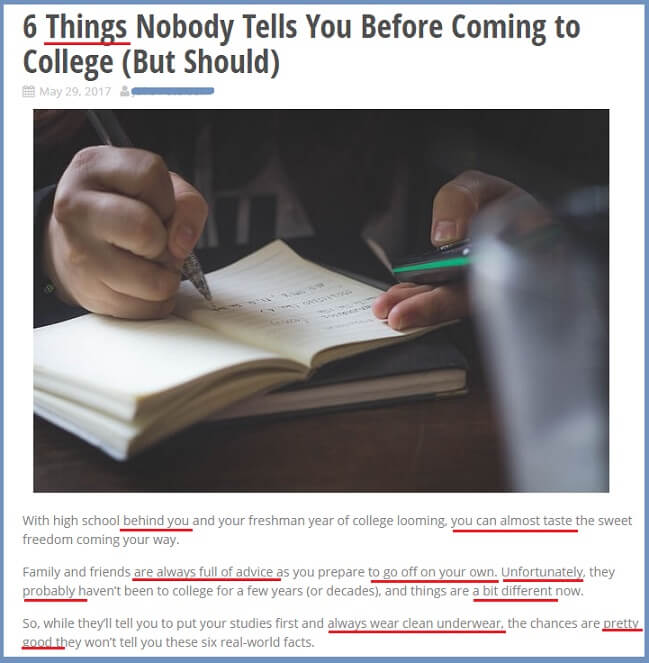
Stop it!
It’s hazy. It’s slushy. It gives no new or useful information. It doesn’t educate, entertain, or encourage to action. Create compelling content, worth reading and sharing; this is a kind of texts bringing organic conversion.
Another matter to consider:
Try to avoid spelling mistakes in writing. Nobody’s perfect, and readers will forgive you one or two typos by all means, but the poor spelling of every other word signals about your disregard of the audience. It frays.
#8. No structure
I bet you know that people scan, not read texts online; and when they read, it’s only 20-28% of the words on your site what they cover. That’s all because reading online is more difficult and 25% slower than from print.
So why make it challenging for visitors to acquire your information and calls to action? Why ignore structuring your web texts?

Subheadings, short paragraphs, lists, bullet points, images, color-contrast ratio, font size, text fields, right align – they all are crucial aspects of content usability able to kill as well as reanimate your text conversion rate. Why not consider them for neat marketing results?
In a word…
Aforementioned blunders are among major writing mistakes some marketers forget when crafting sales copies. While these missteps are prosy, the cart remains there still in 2017: many come across them online, agree?
Do any of these mistakes sound familiar? If so, it’s high time to check your texts and correct them.
Sure, we all are humans putting a foot wrong sometimes.
But remember:
He is not a winner who makes no mistakes, but he who makes them rarer.
